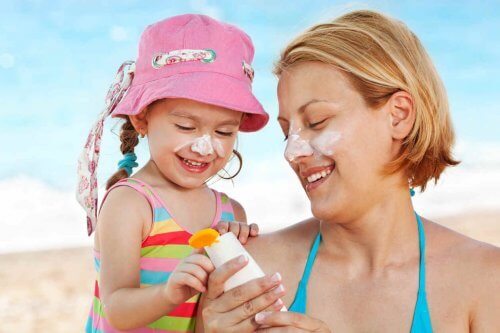Sun Protection in Children: What You Should Know

Lately, experts have detected an alarming increase in cases of skin cancer. Exposure to ultraviolet radiation during childhood plays a key role in the development of melanomas in adulthood. Therefore, sun protection in children is vital.
Children are much more exposed to the sun than adults. Experts believe that, before the age of 21, children receive between 50 and 80% of all the solar radiation they’ll receive in their entire lives. Thus, properly protected children are at a 78% lower risk of developing skin cancer.
How does solar radiation act?
Solar radiation is the set of electromagnetic radiation the sun emits. These are distributed from the infrared to the ultraviolet. However, not all the radiation reaches the surface of the Earth, because atmospheric gases absorb a part of it.
5% of the sunlight that reaches the Earth corresponds to ultraviolet radiation. According to their wavelength, they’re classified into:
- UVA (320-400 nm). Along with visible light, it’s the most abundant radiation. It deeply penetrates the skin and is related to photoaging and decreased immune response.
- UVB (290-320 nm). It reaches the Earth’s surface attenuated by the ozone layer. It’s the main cause of erythema, sunburn, and carcinogenic effects.
- UVC (100-290 nm). Completely blocked by the ozone layer.

Factors such as latitude, altitude, the season of the year, and time of day, among others, affect the arrival of ultraviolet rays at the Earth’s surface. However, at a greater or lesser degree, ultraviolet rays cause damage to our DNA and are responsible for the development of skin cancer.
What does sun protection consist of?
Photoprotection or sun protection consists of preventing the skin damage that ultraviolet radiation causes. There are different types of measures to protect the skin from this aggression.
The human body has endogenous photoprotection mechanisms it uses to naturally protect itself from radiation. These factors depend on each individual. Some of them are:
- Increasing the thickness of the corneal layer.
- DNA repair.
- Synthesis of antioxidant molecules.
- Increased melanin production.
Nevertheless, you can apply other exogenous measures to avoid the damage of sun exposure. They’re what we call physical measures. Some of them are:
- Preventing or reducing sun exposure, especially between 12:00 and 4:00 pm.
- Covering the skin with appropriate clothing and hats.
- Using sunglasses with sun protection.
- Using sunscreen.
Sun protection measures in children
As we mentioned above, children receive up to three times more solar radiation than adults, which is why you should be especially careful with them and increase sun protection measures.
It’s important to note that, between 12:00 and 4:00 pm, solar radiation is high. Therefore, adults and children alike should avoid direct sun exposure during these hours of the day. You should encourage them to stay in shady places.
During sun exposure, they should cover the largest possible part of their bodies with clothing, including caps or hats. Nylon, silk, and polyester are the fabrics that protect the most. Dark colors are preferable because they increase protection.
Another important point to consider is the eyes. Sunglasses protect both the eyes and the delicate area around the eyes. They have to be doctor-approved and offer UV protection.
Sunscreen
Sunscreen is the most-known sun protection measure. Its function is to attenuate ultraviolet radiation through different mechanisms.

Health authorities regulate the safety of sunscreens. Nevertheless, it’s wise to choose well within the many different options on the market, as some sunscreens are more complete than others.
However, sunscreens often pose a problem. People believe that they can stay exposed to the sun for longer if they’re using sunscreen, for example. However, we receive more solar radiation that way than short exposures without sunscreen.
We also tend to think that sunscreen is only necessary when we aren’t tan yet or only if it’s sunny. All this is false and dangerous. It’s necessary to protect yourself from the sun even on cloudy days and when your skin is tanned.
For sunscreens to be effective, they must be used correctly. You should apply sunscreen 30 minutes before exposing yourself to the sun and reapply it approximately every two hours. Also, it’s important to reapply the product after swimming or intense activity.
As for the recommended sun protection factor, in the case of children, it’s always the highest. In other words, SPF 50. Children under six months shouldn’t be directly exposed to the sun. In addition, experts advise against applying sunscreen on them.
In short, sun protection in children is essential to avoid serious future problems. Babies and young children are most susceptible to the harmful effects of radiation and it’s your responsibility to properly care for and protect them.
Lately, experts have detected an alarming increase in cases of skin cancer. Exposure to ultraviolet radiation during childhood plays a key role in the development of melanomas in adulthood. Therefore, sun protection in children is vital.
Children are much more exposed to the sun than adults. Experts believe that, before the age of 21, children receive between 50 and 80% of all the solar radiation they’ll receive in their entire lives. Thus, properly protected children are at a 78% lower risk of developing skin cancer.
How does solar radiation act?
Solar radiation is the set of electromagnetic radiation the sun emits. These are distributed from the infrared to the ultraviolet. However, not all the radiation reaches the surface of the Earth, because atmospheric gases absorb a part of it.
5% of the sunlight that reaches the Earth corresponds to ultraviolet radiation. According to their wavelength, they’re classified into:
- UVA (320-400 nm). Along with visible light, it’s the most abundant radiation. It deeply penetrates the skin and is related to photoaging and decreased immune response.
- UVB (290-320 nm). It reaches the Earth’s surface attenuated by the ozone layer. It’s the main cause of erythema, sunburn, and carcinogenic effects.
- UVC (100-290 nm). Completely blocked by the ozone layer.

Factors such as latitude, altitude, the season of the year, and time of day, among others, affect the arrival of ultraviolet rays at the Earth’s surface. However, at a greater or lesser degree, ultraviolet rays cause damage to our DNA and are responsible for the development of skin cancer.
What does sun protection consist of?
Photoprotection or sun protection consists of preventing the skin damage that ultraviolet radiation causes. There are different types of measures to protect the skin from this aggression.
The human body has endogenous photoprotection mechanisms it uses to naturally protect itself from radiation. These factors depend on each individual. Some of them are:
- Increasing the thickness of the corneal layer.
- DNA repair.
- Synthesis of antioxidant molecules.
- Increased melanin production.
Nevertheless, you can apply other exogenous measures to avoid the damage of sun exposure. They’re what we call physical measures. Some of them are:
- Preventing or reducing sun exposure, especially between 12:00 and 4:00 pm.
- Covering the skin with appropriate clothing and hats.
- Using sunglasses with sun protection.
- Using sunscreen.
Sun protection measures in children
As we mentioned above, children receive up to three times more solar radiation than adults, which is why you should be especially careful with them and increase sun protection measures.
It’s important to note that, between 12:00 and 4:00 pm, solar radiation is high. Therefore, adults and children alike should avoid direct sun exposure during these hours of the day. You should encourage them to stay in shady places.
During sun exposure, they should cover the largest possible part of their bodies with clothing, including caps or hats. Nylon, silk, and polyester are the fabrics that protect the most. Dark colors are preferable because they increase protection.
Another important point to consider is the eyes. Sunglasses protect both the eyes and the delicate area around the eyes. They have to be doctor-approved and offer UV protection.
Sunscreen
Sunscreen is the most-known sun protection measure. Its function is to attenuate ultraviolet radiation through different mechanisms.

Health authorities regulate the safety of sunscreens. Nevertheless, it’s wise to choose well within the many different options on the market, as some sunscreens are more complete than others.
However, sunscreens often pose a problem. People believe that they can stay exposed to the sun for longer if they’re using sunscreen, for example. However, we receive more solar radiation that way than short exposures without sunscreen.
We also tend to think that sunscreen is only necessary when we aren’t tan yet or only if it’s sunny. All this is false and dangerous. It’s necessary to protect yourself from the sun even on cloudy days and when your skin is tanned.
For sunscreens to be effective, they must be used correctly. You should apply sunscreen 30 minutes before exposing yourself to the sun and reapply it approximately every two hours. Also, it’s important to reapply the product after swimming or intense activity.
As for the recommended sun protection factor, in the case of children, it’s always the highest. In other words, SPF 50. Children under six months shouldn’t be directly exposed to the sun. In addition, experts advise against applying sunscreen on them.
In short, sun protection in children is essential to avoid serious future problems. Babies and young children are most susceptible to the harmful effects of radiation and it’s your responsibility to properly care for and protect them.
All cited sources were thoroughly reviewed by our team to ensure their quality, reliability, currency, and validity. The bibliography of this article was considered reliable and of academic or scientific accuracy.
- Magliano, Julio, Álvarez, Mariela, Salmentón, Marina, Larre Borges, Alejandra, & Martínez, Miguel. (2011). Revisión del tema Fotoprotección en los niños. Archivos de Pediatría del Uruguay, 82(2), 98-103.
- Saéz-de Ocariz, Marimar, & Orozco-Covarrubias, Ma. de la Luz. (2015). Protección solar en el paciente pediátrico. Acta pediátrica de México, 36(4), 364-368.
- Eisman, A. B., Negro, J. E. M., Lázaro, M. C. P., & Ortega, S. S. (2009). Factores asociados con el uso de fotoprotección en niños. Piel, 24(1), 12-16.
This text is provided for informational purposes only and does not replace consultation with a professional. If in doubt, consult your specialist.








